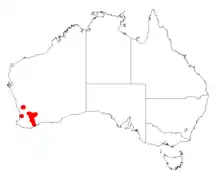Acacia arcuatilis
Acacia arcuatilis is a shrub belonging to the genus Acacia and the subgenus Juliflorae that is endemic to south western parts of Australia.
| Acacia arcuatilis | |
|---|---|
| Scientific classification | |
| Kingdom: | Plantae |
| Clade: | Tracheophytes |
| Clade: | Angiosperms |
| Clade: | Eudicots |
| Clade: | Rosids |
| Order: | Fabales |
| Family: | Fabaceae |
| Clade: | Mimosoideae |
| Genus: | Acacia |
| Species: | A. arcuatilis |
| Binomial name | |
| Acacia arcuatilis | |
 | |
| Occurrence data from AVH | |
Description
The rounded spreading shrub can grow to a height of 0.4 to 1.5 metres (1 to 5 ft).[1] The sericeous branchlets have red-brown or yellow-brown resin-ribs at the extremities. Like most species of Acacia it has phyllodes rather than true leaves. The evergreen shallowly to strongly incurved phyllodes occasionally curl back to a full circle. The grey-green and terete phyllodes have a length of 3 to 6 cm (1.2 to 2.4 in) and a diameter of 0.6 to 1.2 mm (0.024 to 0.047 in) and are hairy in the furrows between the nerves. There are usually eight wide and flat topped nerves per face.[2] It flowers from June to August producing spherical yellow flowers.[1] The simple inflorescences usually occur in pairs in the axils and have spherical flower-heads with a diameter of 4 to 5 mm (0.16 to 0.20 in) and contain 10 to 22 golden coloured flowers. Following flowering thinly coriaceous seed pods for that have a linear shape but are slightly raised over and constricted between each of the seeds. The straight to slightly curved pods have a length of as much as 6 cm (2.4 in) and a width of 1.5 to 2 mm (0.059 to 0.079 in) and have hairs on the faces and wide margins. The seeds inside the pods are arranged longitudinally and are glossy and mottle with an elliptic shape with a length of 2 to 2.5 mm (0.079 to 0.098 in) with a conical aril that is about as long as the seed.[2]
Distribution
It is native to areas of the Wheatbelt and the Great Southern regions of Western Australia.[1] The plant will grown in loam, sand or lateritic soils and is often found on the plains or rises.[1] The bulk of the population is found around Bindi Bindi in the north down to around Ongerup in the south and as far east as Hyden where is most often a part of open mallee scrub and less frequently open heath communities.
See also
References
- "Acacia arcuatilis". FloraBase. Western Australian Government Department of Parks and Wildlife.
- "Acacia arcuatilis R.S.Cowan & Maslin, Nuytsia 12: 472 (1999)". WorldWideWattle. Western Australian Herbarium. Retrieved 9 March 2020.
